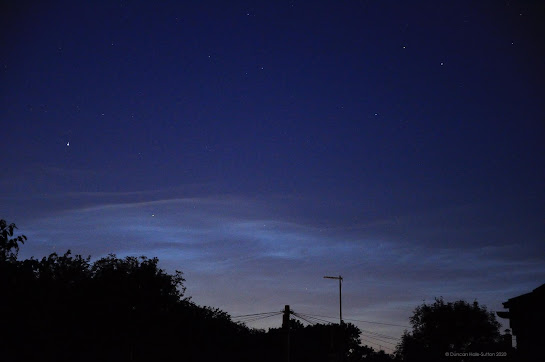Here is another picture from last year when we had a display of noctilucent clouds.
These clouds are unusual in that they only appear in the mid-summer months and are formed at very high altitudes (typically 80 to 85km). They are made up of ice crystals that are lit by the sun which at this time of year is not far below the northern horizon. This picture was taken on the 22nd June 2020 just after midnight. I used a Nikon D90 with a 5s exposure at f/5.3 (ISO1600). The focal length was 80mm.
I wrote an article for the Kielder Observatory Newsletter in 2015 about NLC's and I reproduce it here:-
"During the summer months when the sky isn’t dark enough for
deep sky observing you might be tempted to put up your astronomical feet and
turn your attention to other pursuits. However, there are plenty of projects
you can still get involved in and one of these is observing Noctilucent Clouds
(NLC’s).
Literally meaning “night shining clouds”, these wispy
formations start appearing in the summer months from about mid-May to
mid-August and can be seen above the northern horizon from most parts of the
UK. They tend to appear about an hour and half to two hours after sunset (or
before sunrise) and look like bands or whirls of silvery blue coloured clouds. The British Astronomical Association gives a guide to observing and recording
these phenomena and classifies the different types of cloud that you can see
into four categories: -
1.
Veil (a simple structureless sheet)
2.
Bands (lines or streaks)
3.
Waves or Billows (fine herring-bone
structure like the sand ripples on a beach at low tide)
4.
Whirls (largescale looped or twisted
structures).
So how do these clouds come about? The first point to make
is that they are formed at very high altitudes of 80 to 85km and appear to
shine at night because they are lit by the sun which during the summer lies not
far below the horizon at UK latitudes. At
this point in the upper Mesosphere the temperature is -180C and, by mechanisms
that are yet not fully understood, the clouds form when water vapour freezes
around tiny dust particles. So where does the water vapour and the dust
particles come from? Interestingly, this is the altitude at which some meteors
entering our atmosphere burn up through the intense heat of friction with the
air. It has been suggested that this may be a source of the fine particles of
dust. But what about the water vapour? Here some of our bovine friends may be
helping as it suggested that methane may be reaching this height where, by some
chemistry involving free radicals, its hydrogen is being converted into water.
So why are NLC’s of interest to scientists and why are
amateurs needed to observe them? Firstly, NLC’s are observed to be a recent
phenomenon. The first reports of their observation came in 1885. This is two
years after the massive eruption of Krakatoa when large amounts of ash, dust
and gas were ejected into the upper atmosphere. Secondly, they are being
observed more frequently and at increasing lower earth latitudes. The accepted
view is that NLC’s can be seen from latitudes of 50 to 65 degrees (north or
south; they are seen in the southern hemisphere in summer too) but more recently
they have been seen as far south as 40 degrees. So this is where amateurs can
play a part. In 2007 NASA launched the AIM satellite to observe
these clouds but observations from amateurs is encouraged to
supplement our understanding of their range and frequency. What’s more they may be an indicator of
climate change, perhaps because, as the earth warms up more methane is released
from frozen arctic bogs and this is contributing to the overall methane content
of our air.
In any case, it all makes it a good reason to
stay up late on summer evenings and look out for these enigmatic clouds."
All text and images © Duncan Hale-Sutton 2021








